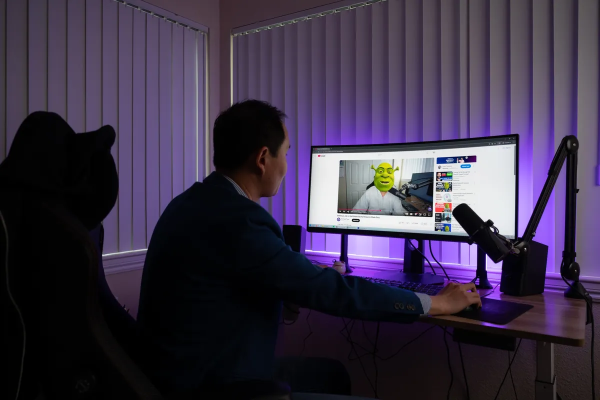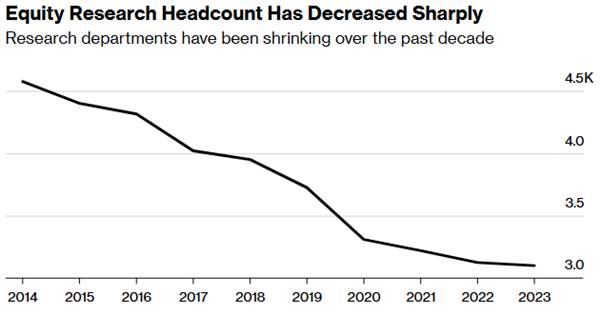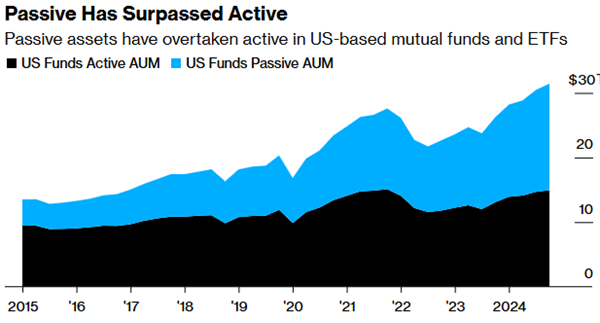|

Illustration: Virginia Gabrielli
|
Markets
| The Big Take
How Analyst Job Cuts on Wall Street Are
Reshaping Equity Research
Forces like regulation, passive investing and AI have all conspired to
squeeze equity research in ways few could have imagined. Countless
“sell-side” analysts have had to reinvent themselves as a result.
By Sujata
Rao, Denitsa
Tsekova, and Isolde
MacDonogh
January 8, 2025
at 5:00 PM EST
Jerry Diao had all the makings of a successful Wall Street
analyst. A degree in statistics from UC Berkeley. An MBA from NYU. And
a job in equity research at a big bank covering Silicon Valley tech
stocks.
But instead of a life of market-moving stock
calls, six-figure bonuses and glad-handing execs on another great
quarter of earnings, these days, Diao plies his trade on social
media, dishing out advice on the finance industry. On YouTube, Diao
goes by the nom de guerre “Richard Toad,” and until recently, he
masqueraded his irreverent
takes behind an avatar of Shrek.
It’s been humbling for Diao, who started out
in so-called sell-side research six years ago. He’s had to move back
home to Northern California, and despite a 40,000-strong following,
his “five-figure income” is just a third of what he used to earn. But
after trying, and failing, to get back into the industry after leaving
Wall Street in 2022, Diao has little choice. Making it as a “content
creator,” he says, is the No. 1 goal now.
|

Jerry
Diao previously used a "Shrek" avatar to hide his face in his
videos before going public.
Photographer: Mike Kai Chen/Bloomberg
|
“Maybe in hindsight, I will thank all the
companies that rejected me,” he said.
Diao, 37, is just one of scores of former
analysts who’ve had to reinvent themselves in recent years in the face
of a seismic upheaval reverberating through Wall Street.
The pandemic did, briefly, fuel a burst of
hiring in equity research but when it faded, it left the same potent
forces in place that have been gutting the industry for years. Regulations on
how banks charge for research, a shrinking market
for publicly listed companies, and the popularity of index-tracking
funds have conspired to squeeze equity research in ways few could have
imagined even a decade ago. Leaps in artificial intelligence only
threaten to accelerate that
trend, with firms like JPMorgan already experimenting with AI-powered
analyst chatbots,
sowing deeper doubts about the value of fundamental analysis and
whether investors will keep paying for it.
Compared with their post-financial crisis
peak, it’s estimated that the biggest banks globally have slashed the
ranks of equity analysts by over 30% to lows not seen in at least a
decade. Those who remain often cover twice, or even three times, as
many companies.
The fallout is already
reshaping Wall Street.
And the pay, while still far higher than most jobs in industries
outside finance, has stagnated. For example, starting salaries for
entry-level equity analysts currently range from $110,000-$170,000 a
year, barely above their levels before the financial crisis, according
to Vali
Analytics.
They have been climbing of late — up by some
$20,000 on average from a low in 2020. But after taking inflation into
account, total compensation remains about 30% lower than it was
pre-crisis, the data show.
The fallout is already reshaping Wall Street.
It’s also having knock-on effects on the structure of the stock market
itself, in how individual companies, both big and small, are valued.
(More on that later.)
No one expects compensation to return to the
heyday of the late ’90s and early 2000s, of course, when star analysts
like Mary Meeker and Jack Grubman were fêted like celebrities and
reportedly made upwards of $15 million or more, and stock
recommendations, more often than not, were geared toward winning
underwriting business for their banking arms. And it’s not too hard to
understand why equity analysts might be in the crosshairs as
automation proliferates, investors embrace cheap, passive-investing
strategies like ETFs and the broader market keeps hitting record after
record.
Nevertheless, the numbers underscore an
industry in steep decline.
At the world’s 15 biggest banks, the number
of equity analysts has fallen to about 3,000 from almost 4,600 a
decade ago, according to Vali Analytics. The biggest cuts have
occurred in Europe and Asia, excluding Japan. Data from Coalition
Research shows a similar decline. Apart from an outlier or two,
the reductions have been widespread and few equity research
departments have been spared. Industry insiders say Citigroup and
Deutsche Bank were among the more notable banks in paring headcount.
Both declined to comment. (Bloomberg LP, the parent company of
Bloomberg News, produces equity research that competes with analysis
from Wall Street firms.)
|

Source: Vali Analytics. Data cover
cash equity research headcount at the world’s 15 biggest banks
|
Meanwhile, despite a small uptick in the
first half of last year, spending on research globally has sunk 50%
since 2018, data from Substantive Research show. That year, MiFID
II was enacted, forcing asset managers in the UK and European
Union to pay for research, rather than offering it for free as part of
a suite of services. US brokers supplying research to Europe-based
managers also became subject to the rule two years ago.
The result? Equity research has become “an
orphaned child that’s always looking for a home,” according to Robert
Buckland, who was Citigroup’s head of equity strategy until 2023.
Some former analysts have managed to find
work at hedge funds, while others have jumped ship to work in investor
relations at firms they once covered. Buckland himself is now at a
startup called EngineAI, which applies AI programs to various fields,
including equity research.
For those who have stuck around, job security
is tenuous.
Take, for instance, George O’Connor. The
technology analyst has bounced around London from one firm to the next
in recent years, and has now worked for a half-dozen shops since
becoming an equity analyst in the late 1990s. Currently at Progressive
Equity Research, O’Connor says the “unbundling” of research from
trading, ostensibly meant to level the playing field, gave big banks
an upper hand because they could charge less for more wide-ranging
coverage.
“There was also a flight to cheap driven by
much larger global providers, which sort of knocked smaller companies
out of the water,” he said. “It’s just economics 101.”
You don’t get the “same level
of information you had when a
company had 20 people covering
it.”
Individual analysts are saddled with more
companies to cover, leaving less time for in-depth analysis. According
to Zaki
Ahmed, a veteran headhunter who runs recruiting firm Financial
Search, banks often want analysts to cover as many as 20 stocks as
they shrink their research teams.
The buyside is feeling the pinch, too. Matt
Stucky, a money manager at Northwestern Mutual Wealth Management, says
there either simply aren’t enough analysts covering the companies he’s
interested in or they’re spread too thin. As a result, he’s had to do
more of the legwork himself to get the answers he wants.
You don’t get the “same level of information
you had when a company had 20 people covering it,” Stucky said.
Currently, companies in the Russell 2000
Index with fewer than 10 analyst recommendations have ballooned to
some 1,500 from 880 a decade ago, an increase of 70%, data compiled by
Bloomberg show. Conversely, coverage has become concentrated in the
biggest names. Today, about 97% of the S&P 500 have 10 or more
ratings, up from about two-thirds in 2014.
A growing body of evidence suggests stocks
that fall off the sell-side radar often struggle to attract investors,
distorting valuations and making markets less efficient.
One academic paper,
which looked at data over a 40-year period, showed how investors
consistently over- or undervalued companies covered by fewer analysts.
Another study found firms
that had a decrease in coverage showed a significant decline in
investor recognition, increasing their cost of capital. A third showed
that low-coverage stocks traded less and had wider bid-ask spreads,
while “orphaned” companies were far more likely to be delisted.
They’re also more likely to underperform.
Small-cap companies with no coverage, for example, have lagged behind
those covered by more than 10 analysts by nearly 3 percentage points a
year since 2001, according to Steven DeSanctis, a small- and mid-cap
strategist at Jefferies.
|

Source: Bloomberg Intelligence
|
“For small companies that are already covered
by fewer analysts to start with, each one less will hurt them more,”
said Kevin
Li, a professor at Santa Clara University and co-author of one of
the papers. “The downtrend is probably not preventable, given the move
away from active investment. Now, with AI, we could see that (human)
role reduce further.”
Part of the irony is that the lack of
in-depth analysis which asset managers bemoan is a direct consequence
of their unwillingness to pay for it. And as they “continue to spend
less and less” for bank research, Integrity Research’s Mike
Mayhew says they’ll likely look for more cost-effective ways to
fill the gaps.
That includes relying on in-house analysts or
non-bank sources like those on blogging platform Substack, often
written by the very analysts caught up in budget cuts and staffing
culls. Northwestern Mutual’s Stucky subscribes to a few himself and
values their “unfiltered” takes. (He declined to identify them.)
Indeed, online finance blogs have exploded in
recent years, with Substack estimating it now hosts tens of thousands
of them.
One is written by Alex
Morris. He runs TSOH Investment Research (it stands for The
Science Of Hitting — he’s a big baseball fan), which has
racked up nearly 700 paid subscribers since 2021. At $499 annually,
that equates to roughly $260,000 a year after fees, etc. — more than
double what he earned at the Fiduciary Group, a small investment
adviser in Savannah, Georgia.
Morris discloses his recommendations at 5
p.m. Eastern time and then invests in them the next day. Last year,
his 10-stock portfolio, which included Netflix and Meta, returned 21%,
versus the S&P 500 Index’s 23% gain. It’s the third time in the past
four years that he’s fallen short of his benchmark, yet he’s continued
to attract followers despite his mixed record.
Asked why they should stick with him rather
than buying an ETF, Morris says history suggests the S&P 500’s outsize
gains won’t likely last. Part of his draw, he says, is that he talks
about his winners and losers and puts all his investable assets behind
his calls.
“The industry has had issues in the past in
terms of what the person writing the research actually thinks, versus
what they would do if they were managing their own money,” he said.
Another is by Barry
Knapp, a longtime strategist who built a following over four
decades on Wall Street with Lehman Brothers, BlackRock, and most
recently, Guggenheim. He currently has “hundreds” of paying Substack subscribers,
each of whom forks over $999 a year for his macro research.
His home office faces the slopes of Vail,
Colorado, a nice change from his commutes into Manhattan. But Knapp
says that even with his résumé and built-in following, the market for
sell-side research isn’t what is used to be.
“For someone like me to go back and work on
the Street for a number that is not even close to what I was making in
2000?” Knapp mused. “What would be the point?”
|

Jerry Diao
Photographer: Mike Kai Chen/Bloomberg
|
Reliable figures on how lucrative financial
blogging is as a full-time profession are scant, as is data on how
many analysts have parlayed their Wall Street bona fides into genuine
success on social media. While some, like Morris and Knapp, have
managed to make it work, the signs suggest that most end up toiling
away in relative obscurity.
Back in the San Francisco Bay Area, Diao
continues to create content on YouTube, Substack and Instagram, hoping
one day to break through.
He touts the benefits of his newfound
vocation. No need to dress up or commute to the office, no more
80-hour weeks. He can produce all his blogs and podcasts in his
bedroom with a laptop and a microphone.
All he needs now is a little bit of luck —
and a few more paying subscribers.
“These kinds of things, once they hit
critical mass, can suddenly become big enough to pay rent and put
meals on the table,” Diao said. “And at this point, that’s all I’m
hoping for, because the freedom that comes with it, you can’t put a
price on that.”
| ©2025 Bloomberg
L.P. All Rights Reserved. |
|




